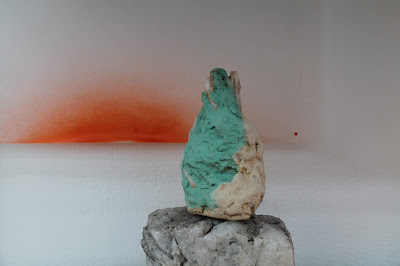Building an Ecosystem From Scratch
Test Space, Spike Island
Polly Kelsall
22ndJune – 8thJuly 2018
What can be seen here is a synthetic ecosystem – where the natural meets the human made.
These individual found and made components (actants, things, materials, objects) are occupying the same space and sharing layers. They co-exist. They come from the same resources and have been organised and ordered to create a whole system. Everything is connected and dependent on one another. This ecosystem is about materials, processes and connections. It is dynamic; subject to periodic disturbances and is in the process of recovering and adapting from past disturbances.
Glossary
Ecosystem– a community of components (actants, things) together in the habitat where they live. These actants are interacting and interdependent; they make up a self-contained system.
Habitat– the place where a particular population lives and its surroundings (the geographical area occupied by an ecosystem).
Symbiosis– relationship in which 2 actants live closely together, usually benefitting from each other.
Bioregion– a unique place with its own distinct characteristics.
Carrying Capacity– maximum population of a particular thing that a given habitat can support over a given period of time.
Competition– 2 or more actants attempting to use the same scarce resources in the same ecosystem.
Immature community– a community at an early stage of ecological succession.
Mature community– a stable, self-sustaining community in an advanced stage of ecological succession. It has a diverse array of actants.
Keystone component– actants that play roles affecting many other actants in an ecosystem.
Native component– things that normally live and thrive in a particular ecosystem.
Climax community– a community of things that have reached a stable state.
Cooperation– the process by which actants work together for mutual benefit.
Disturbance– a discrete event in time and space that alters the structure of populations, communities and ecosystems.
Dominance hierarchy– the organization of individual actants into groups with a social structure.
Resource sharing– actants relying on the same resources.
Ecophagy – the destruction of an ecosystem.
Acclimation– adjustment to slowly changing new conditions.
Exotic components– an introduced actant/thing that is not native or endemic to a habitat. Components provided byJoy Bailey.
Foundation components– an actant that is a dominant primary producer in its ecosystem, both in terms of abundance and influence on other things and the environment.
Human ecology– a branch of ecology that studies the relationships between humans and their natural, social and built environments.
Emergence– the whole is greater than the sum of the parts.
Indicator component– any actant that defines a trait or characteristic of its environment.
Cement – a fine grey powder made of a mixture of limestone and clay.
Concrete– a building material made of cement, sand, aggregate and water.
Plaster- a mixture of lime, sand and water. Applied as a soft paste and hardens when dry.
Plastic– synthetic materials that have a polymeric structure. Can be moulded when soft and then set.
Peat – a compact brownish deposit of partially decomposed vegetable matter saturated with water.
Paint– a mixture consisting of a solid pigment suspended in a liquid that dries.
Anorthosite– an igneous white/grey rock consisting of feldspar. It is rare in Great Britain but common on the Moon.
Soil – the top layer of the land surface that is composed of disintegrated rock particles, humus, water and air.
















